September 15 marks 33 years since Muhammad Ali vanquished Leon Spinks in an epic bout, becoming the first and only pugilist to win the lineal world heavyweight championship three times. In a life sparked with charm and controversy, fame and fallibility, the fighter who once answered to the name of Cassius Marcellus Clay, Jr has become one of the most recognizable sportspersons of our time. Forget for a minute the present-day image: His tongue-tied, wheelchair-shackled frame, or that once-animated face turned wooden by Parkinson 's disease. Forget his bragging and taunting. Forget the zealots who have (now that he is down for the count) gained the courage to attack him. In his time, Ali elevated boxing to a prime gladiator sport, not the brawling street-fighting nadir to which it has descended. Black. American. Muslim. The three prongs of his identity weighed heavily on Ali's shoulders but he confronted and tamed his demons. The fighter who could "float like a butterfly and sting like a bee" once quipped bitterly, "Boxing is a lot of white men watching two black men beat each other up."
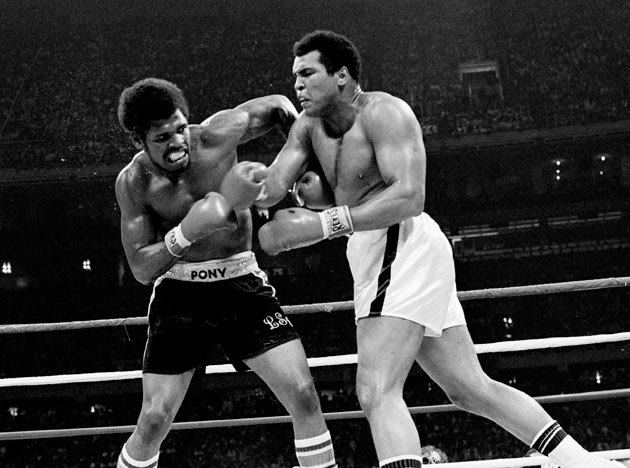
September 15, 1978, boxer Muhammad Ali won the World Boxing Association Heavyweight title for a record third time, pummeling challenger Leon Spinks into submission at the New Orleans Louisiana Superdome. The fight was a rematch after Spinks' victory over Ali in February that year. It ran into 15 rounds before 36-year-old Ali was announced the unanimous winner

Cassius Marcellus Clay, Jr was born in Louisville, Kentucky on January 17, 1942 to Cassius Clay, Sr, who painted billboards, and Odessa Grady Clay, a domestic help. The story goes that young Clay's bicycle was stolen and he wanted to "whup" the thief, a remark overheard by Louisville police officer Joe Martin who coached fighters. Ali began to train with Martin and later with other trainers. After only five losses in 100 amateur bouts, and several titles, Clay represented the United States at the 1960 Rome Olympics and won gold in the Light Heavyweight category.
In his 1975 biography, Ali wrote that he threw his medal in the Ohio River after being refused entry into a whites-only restaurant. He was given a replacement medal while lighting the torch at the 1996 Olympics in Atlanta

Cassius Clay (right) makes his professional boxing debut on October 29, 1960, in Louisville's Freedom Hall against Tunney Hunsaker, a part-time fighter and police chief of Fayetteville, West Virginia. All of 18 years of age, Clay won the six-round decision before 6,000 fans.
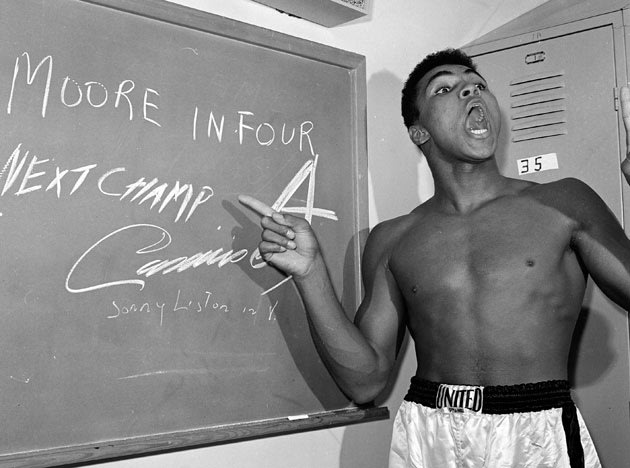
Cassius Clay points to a sign he wrote on a chalk board in his dressing room before his fight against Archie Moore in Los Angeles, November 15, 1962, predicting he'd knock Moore out in the fourth round, which he went on to do. The sign also predicts Clay will be the next champ via a knockout over Sonny Liston in eight rounds. The young boxer's penchant for predicting the precise round in which he would knock out his opponent, and living up to each of his claims, was greeted with both adulation and derision by fans, rivals and media
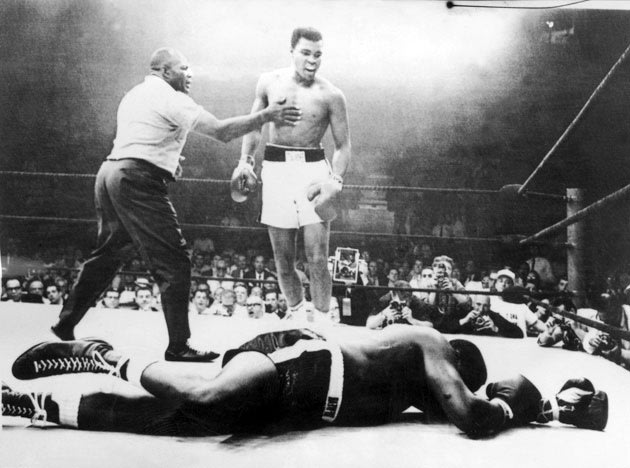
On May 26, 1965 Muhammad Ali, then still answering to Cassius Clay, defeated Sonny Liston (left) after a one-minute fight.
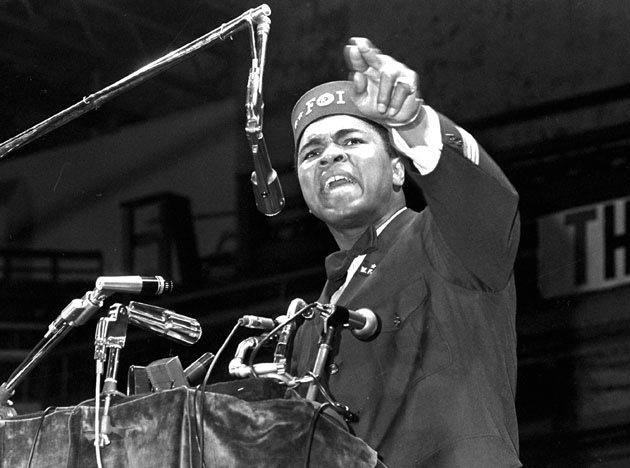
Clay announced his acceptance of Islam the day after winning his celebrated 1964 bout with Sonny Liston, announcing that he would henceforth be called Cassius X. Nation of Islam leader Elijah Muhammad gave him the name Muhammad Ali in a phone message broadcast on radio on March 6, 1964.
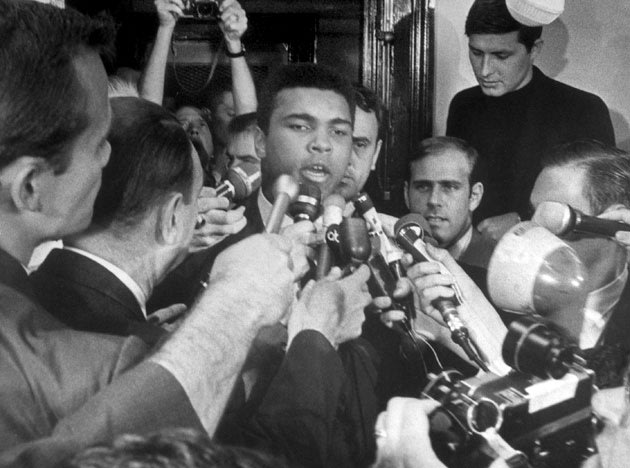
"Man, I ain't got no quarrel with them Vietcong," Muhammad Ali said in a press conference on April 29, 1967. This remark, and his resistance to being drafted to fight the Vietnam War, cost Ali his boxing license and titles. "Why should they ask me to put on a uniform and go ten thousand miles from home and drop bombs and bullets on brown people in Vietnam while so-called Negro people in Louisville are treated like dogs and denied simple human rights?" he asked angrily. Ali appeared in colleges and universities to speak in support of antiwar protests. In 1971, the United States Supreme Court reversed his conviction and his titles were subsequently reinstated
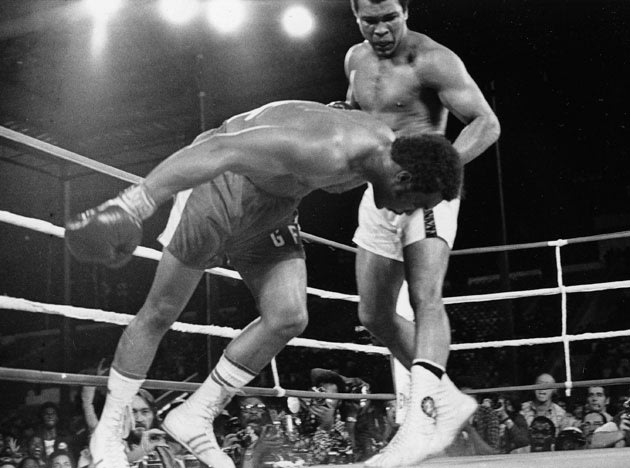
Muhammad Ali watches as defending world champion George Foreman goes down to the canvas in the eighth round of their WBA/WBC championship match in Kinshasa, Zaire, on October 30, 1974. Foreman was counted out by the referee and Ali regained the world heavyweight crown by knockout in the bout dubbed "Rumble in the Jungle." The hulking Foreman had been a force to reckon with, having knocked out Joe Frazier after 95 seconds of the second round in January 1973 in Jamaica. The match was significant, for with this victory Ali regained all of his stripped titles
__________________
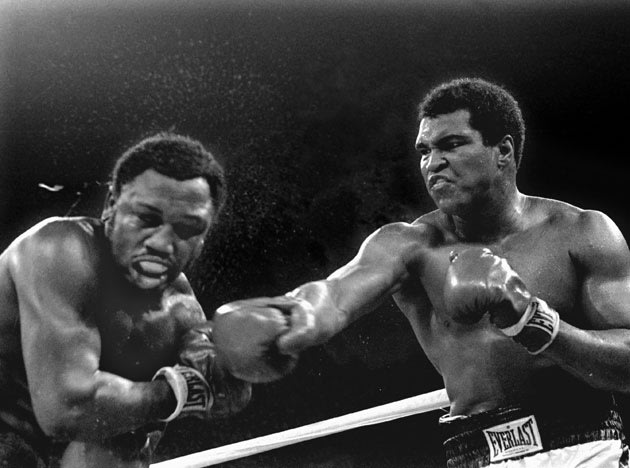
The October 1, 1975 "Thrilla in Manila" was the third and most celebrated bout between the two champions Joe Frazier and Muhammad Ali. Each had won a fight against the other. The match, held in Manila and sponsored by Philippines dictator Ferdinand Marcos to draw international attention away from the martial law he had imposed in the country, invited huge attention. It ran into 14 rounds, sapping the stamina of both fighters, at the end of which Ali brought down a nearly blinded Frazier. After the match Ali announced, "He is the greatest fighter of all times,
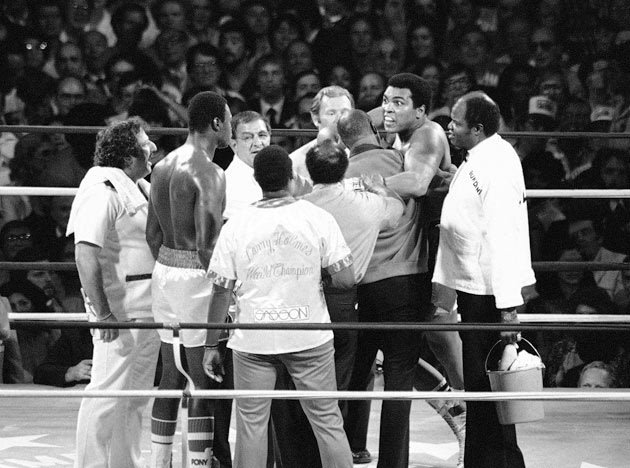
Referees and officials break up a pre-match scuffle between Muhammad Ali and challenger Larry Holmes at Caesars Palace in Las Vegas, October 3, 1980. Ali, who had returned from retirement after his victory over Leon Spinks in 1978, attempted to taunt and provoke Holmes. The match lasted ten rounds, and Ali did not answer the bell for the eleventh. The following year, Ali would lose his last match to challenger Trevor Berbick
.............
No comments:
Post a Comment